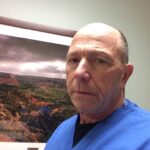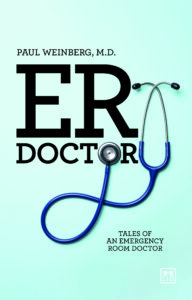|
My Favourite Story From the ER by Paul Weinberg
By Guest Contributor Paul Weinberg, Author of ER Doctor
Everyone has had the brief and generally unpleasant experience of having some small amount of something (usually liquid) go down the wrong way while eating. Coughing strongly for a short time would relieve the episode and you were good to go.
Now imagine that in an extreme.
The cough is too weak in its force to clear it from your throat. Your ability to breathe is blocked. How long can you hold your breath after you’ve been coughing?
Not very long.
You abruptly feel desperate and then you collapse unconscious. Maybe the fall dislodges that something – usually not. You are not getting enough air and the reversible unconsciousness progresses to irreversible death.
Choking is the fourth leading cause of unintentional death behind poisoning, motor vehicle wrecks and falls. It usually affects the extremes of life, babies, toddlers and old folk, all of them just a bit out of the mainstream to be fully capable to avoid the incident.
Common techniques often taught at First Aid classes (i.e. Heimlich manoeuvre) are frequently able to reverse the mechanical blocking of the airway, and when the airway is reopened the choking victim will easily often recover.
This is one of my favourite ER stories that had easily learned lessons and a good outcome:
An older gentleman was enjoying a steak sandwich and a few whiskies in a local restaurant. It was in the late afternoon, and he was dining alone. He preferred his steak well-done. He had a history of dental neglect and now had upper dentures. He also had a history of cigarette smoking.
He was hungry and eating quickly with large bites. The food smelled good, and he was feeling good, too. Suddenly that last big bite of steak did not go down. It got stuck. It got so stuck that he did not have time to dig it out with his hand or call for help. He just collapsed onto the floor.
Fortunately, a patron knew the Heimlich maneuver, and they used that skill multiple times until the paramedics arrived. They stabilized him and brought him to the ER.
By then he was unconscious and blue. His once straight nose was totally smashed to the side. As the Heimlich was applied to this unconscious man, he flexed forward onto the counter with each compression, further displacing his nose. It was the most severe nasal fracture I had ever seen.
His airway needed immediate attention. Using the usual tools of the trade, including a specialized type of pliers, I examined his throat, saw what the problem was and removed a piece of steak the size of my palm that was blocking his airway.
The Heimlich maneuver had opened the airway just enough that he did not die in transport to the hospital. As soon as the foreign body was removed, he began to pink up, and soon he was conscious and alert.
To deconstruct this case, his long history of cigarette smoking gave him less breath-holding time in which to try to save himself. His drinking caused impaired judgment and coordination, which made him less competent to save himself.
The dentures did not allow him the proper feel of food in his mouth and the size of the uncut piece of meat put his case over the edge. He was admitted for observation, did well and had an ear, nose and throat (ENT) specialist fix his nose.
There are wonderfully dramatic cases from a medical standpoint that are easy – basically a chance for the physician to be a hero.
The vigorous Heimlich maneuver, some might say overly vigorous because it pretty much destroyed the patient’s nose but saved his life, opened a time window that allowed advanced airway skills to remove the huge piece of steak and thus have a fully open airway.
Could this have been prevented? Sure, remember what your grandparents would have said:
- Don’t run with something in your mouth
- Don’t talk or laugh too much while eating
- Do cut your food into easy, bite-size portions
- Don’t “wolf” your food down
And, obviously, keep your senses clear – no enfeeblement from drugs or alcohol.
Have a plan and know what to do if this happens solo or to others.
Knowing how to save a life is good.
Saving your own life is better.
ABOUT THE AUTHOR
 Paul Weinberg, MD, a self-confessed adrenaline junkie, spent a total of 45 years in Emergency Medicine primarily in a community hospital in a major metropolitan area in California, USA. He is now retired.
Paul Weinberg, MD, a self-confessed adrenaline junkie, spent a total of 45 years in Emergency Medicine primarily in a community hospital in a major metropolitan area in California, USA. He is now retired.
Suggested Reading
 In turns shocking, sad and funny, this book contains remarkable tales, inside stories and the experiences of a doctor’s career in ER. Emergency medicine in America is a critical asset to its healthcare system. The ER doctor is located at the interface of the public and the first point of healthcare. If a doctor is needed outside of office hours, nights, or holidays, if the patient is uninsured or has inadequate insurance, or is of such a social state that they might be unpleasant to be around, no one is turned away at the ER. In short, the life of the ER doc is one where no situation is off limits.
In turns shocking, sad and funny, this book contains remarkable tales, inside stories and the experiences of a doctor’s career in ER. Emergency medicine in America is a critical asset to its healthcare system. The ER doctor is located at the interface of the public and the first point of healthcare. If a doctor is needed outside of office hours, nights, or holidays, if the patient is uninsured or has inadequate insurance, or is of such a social state that they might be unpleasant to be around, no one is turned away at the ER. In short, the life of the ER doc is one where no situation is off limits.
